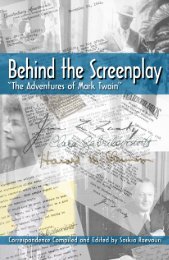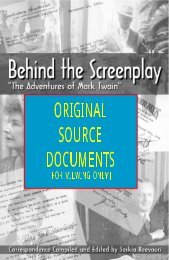Create successful ePaper yourself
Turn your PDF publications into a flip-book with our unique Google optimized e-Paper software.
32 The Making of ARE WE CIVILIZED?EDWIN CAREWE [Director]EDWIN CAREWE (March 5, 1883-January 22, 1940) was anAmerican motion picture director, actor, producer, <strong>and</strong> screenwriter.He was born in Gainesville, Texas, as Jay Fox.After brief studies at the universities of Texas <strong>and</strong> Missouri,he gained experience with regional theatrical groups beforemoving to New York in 1910. As an adolescent stage actor hebecame a member of the Dearborn Stock Company <strong>and</strong> madehis debut on Broadway with Chauncey Olcott. He appeared inplays with Otis Skinner, Rose Coghlan <strong>and</strong> Laurette Taylor inNew York, Philadelphia, Washington, Chicago <strong>and</strong> Los Angeles.In 1912 he changed his name to Edwin Carewe, <strong>and</strong> in 1914entered the film industry as an actor for the Lubin Company ofPhiladelphia. Within a year he made his directorial debut withThe Final Judgement, a film of the Rolfe-Metro Company.Carewe first arrived in Hollywood as a hobo, hopping intoa boxcar hoping to get to warmer weather in Los Angeles.Later he directed films for Metro, Paramount, First National,most famously Resurrection (1927), Ramona (1928),Revenge (1928), Evangeline (1929), <strong>and</strong> The Spoilers (1930),giving early screen exposure to such actors as Dolores del Río,Warner Baxter, Francis X. Bushman <strong>and</strong> Gary Cooper. Althoughhe directed <strong>and</strong> produced a number of critically <strong>and</strong>financially successful silent films, he was not fully able to makethe transition to sound. After resorting to sound remakes of hisearlier successes, <strong>and</strong> later to low-budget <strong>and</strong> religious films, hemade his last feature, Are We Civilized?, in 193<strong>4.</strong>Carewe’s first marriage in 1908 produced two children,Mary Jane <strong>and</strong> actress Rita Carewe. In 1925 Carewe eloped toMexico with actress Mary Akin, with whom he had three children,Sally Ann (1925), William (1927), <strong>and</strong> Carol Lee (1932).Carewe was the brother of director/producer Wallace Fox <strong>and</strong>screenwriter Finis Fox, the latter often collaborating with him<strong>and</strong> writing many of his scenarios.Carewe died January 22, 1940, of a heart ailment in hisHollywood apartment, <strong>and</strong> is buried at Hollywood ForeverCemetery. Among attendees at his funeral were actors WilliamFarnum <strong>and</strong> John Boles.
34 The Making of ARE WE CIVILIZED?WILLIAM FARNUM (“Paul Franklin, Sr.”)WILLIAM FARNUM (July 4, 1876-June 5, 1953) was born inBoston, Massachusetts. The son of actors, he made his actingdebut at the age of ten in Richmond, Virginia, in a productionof Julius Caesar, with Edwin Booth playing the title character.His first major stage success was in 1900, starring in Ben-Hur,in which he toured for five years. Later plays he appeared ininclude The Prince of India (1906), The White Sister (1909), TheLittlest Rebel (1911), <strong>and</strong> Arizona (1913), the latter two co-starringhis brother Dustin.In 1914 William made his movie debut in The Spoilers; therealistic fight scene between Farnum <strong>and</strong> co-star Tom Santschimade stars out of both men. Signing with Fox Films in 1915,Farnum graduated to matinee-idol status <strong>and</strong> for the next tenyears was a popular leading man in such solid vehicles as A Taleof Two Cities (1917), Les Miserables (1917) <strong>and</strong> If I Were King(1920). At his peak he earned $10,000 a week.In 1925, Farnum suffered a serious injury on the set of TheMan Who Fights Alone; as a result, he was confined to supportingroles for the rest of his film career, never again to recapturethe glory of his silent stardom.He returned to the stage in 1925 playing Sir Ralph Morganin The Buccaneer. The following year he appeared in the titlerole of Julius Caesar <strong>and</strong> two years later was on Broadway asBanquo in Macbeth.Until his death, William Farnum remained a busy characteractor in Hollywood, often playing minor roles in remakes ofhis silent triumphs—including the 1942 remake of The Spoilers.He was married three times. In 1896 he wed actress MabelEaton, <strong>and</strong> they were divorced; from 1906 to 1931 he was marriedto actress Olive White, with whom he had a daughter, Adele;<strong>and</strong> in 1932 he married Isabel Major. Farnum was the youngerbrother of actor Dustin Farnum (1874-1929). Another brother,Marshall Farnum (1879-1917), was a silent film director.William Farnum died on June 5, 1953, in Hollywood, California.Pallbearers at his funeral were Cecil B. DeMille, JesseLasky, Frank Lloyd, Clarence Brown, Charles Coburn <strong>and</strong> LeoCarillo.
<strong>Cast</strong> <strong>and</strong> <strong>Crew</strong>35ANITA LOUISE (“Norma Bockner”)ANITA LOUISE FREMAULT (January 9, 1915–April 25, 1970)was born in New York City.At six she appeared on Broadway in Peter Ibbetson, <strong>and</strong> atnine made her film debut in The Six Comm<strong>and</strong>ments. She continuedto make films as a child actor <strong>and</strong> by her late teens wasbeing cast in leading <strong>and</strong> supporting roles in major productions.She dropped her surname in 1929, was a 1931 WAMPAS BabyStar (an annual promotional campaign honoring thirteen youngwomen believed to be on the threshold of movie stardom). In the1930s Anita starred in Warner Bros. dramas such as MadameDuBarry (1934), A Midsummer Night’s Dream (1935), The Storyof Louis Pasteur (1936) <strong>and</strong> Marie Antoinette (1938).Anita was frequently described as one of cinema’s mostfashionable <strong>and</strong> stylish women. After marrying producer BuddyAdler in 1940, her reputation was further enhanced by her roleas Hollywood society hostess, with her parties attended by theelite of Hollywood.During this time her career turned to B movies, in whichshe played girlfriends, sisters <strong>and</strong> daughters. Her last appearanceon the big screen was in Bulldog Drummond in 1947.The advent of television in the 1950s brought new life toAnita’s acting career, when she played Johnny Washbrook’smother, Nell McLaughlin, in the CBS television series, “MyFriend Flicka” (1956-1957). Anita was also the substitute hostof “The Loretta Young Show” (1953), <strong>and</strong> hosted such shows as“Theatre Time” (1957) <strong>and</strong> “Spotlight Playhouse” (1958). Hertelevision guest roles have included “Mannix (1967)” <strong>and</strong> “TheMod Squad” (1968).She <strong>and</strong> Adler had two children <strong>and</strong> remained married untilhis death in 1962. That same year she remarried, to businessmanHenry L. Berger, <strong>and</strong> devoted her final years to charitablepursuits like the Children’s Asthma Research Center <strong>and</strong> theNational Hemophilia Foundation.She died of a stroke in West Los Angeles on April 25, 1970.
36 The Making of ARE WE CIVILIZED?FRANK MCGLYNN (“General Bockner/Abraham Lincoln”)FRANK MCGLYNN (October 26, 1866-May 18, 1951) wasborn in San Francisco, California.Tall <strong>and</strong> comm<strong>and</strong>ing, McGlynn made his 1896 stagedebut in The Gold Bug. Eleven years later, he entered films as amember of the Edison Company. In 1919, he starred on Broadwayin John Drinkwater’s play Abraham Lincoln. Thereafter,McGlynn was best known as Hollywood’s foremost Lincoln impersonator,playing Lincoln no fewer than seven times between1934 <strong>and</strong> 1937.McGlynn appeared in 121 films between 1911 <strong>and</strong> 1947,most notably Who Will Marry Mary? (1913), The Poor LittleRich Girl (1917), Lady <strong>and</strong> Gent (1932), Hearts in Bondage(1935), The Littlest Rebel (1935), Prisoner of Shark Isl<strong>and</strong> (1936),The Plainsman (1936), Wells Fargo (1937), The Lone Ranger asAbraham Lincoln (1939), <strong>and</strong> the Warner Bros. historical shortLincoln at the White House (1939).The actor’s best-known non-Lincoln screen roles includedDavid Gamut in Last of the Mohicans (1920) <strong>and</strong> Patrick Henryin D.W. Griffith’s America (1924). In the 1930 musical GoodNews, McGlynn was afforded a rare opportunity to play comedyas a sarcastic college dean.His son, Frank McGlynn, Jr., (1904-1939), was also a busyfilm actor, usually seen in hillbilly <strong>and</strong> cowboy roles.Frank McGlynn Sr. died on May 18, 1951, in Newburgh,New York.
<strong>Cast</strong> <strong>and</strong> <strong>Crew</strong>37LEROY MASON (“Paul Franklin, Jr.”)LEROY MASON (July 2, 1903-October 13, 1947) was born inLarimore, North Dakota.Mason entered films in the mid-’20s as Roy Mason, playingmostly juveniles <strong>and</strong> leading roles.After the advent of talkies, his oily, sneering voice typedhim as a bad guy, appearing opposite nearly every Western staron the Hollywood prairie, a career that included quite a few actionserials as well.With John Wayne he made Maker of Men (1931), TexasTerror (1935), Rainbow Valley 1935), California Straight Ahead!(1937), Santa Fe Stampede (1938), Wyoming Outlaw (1939), NewFrontier (1939).By the 1940s, he had become one of the busiest characteractors in Hollywood, switching from 20th Century-Fox to Republic<strong>and</strong> back again. Notable films include Raiders of SunsetPass (1943), Lucky Cowboy (1944), The Tiger Woman (1944),Chetniks! The Fighting Guerrillas (1943). As the villain in Republicserials, he starred with, among others, Tom Mix <strong>and</strong> GeneAutry <strong>and</strong> was known as “the backbone of Republic.”The hectic schedule took its toll, however, when he suffereda fatal heart attack on the set of the 1947 Monte Hale westernCalifornia Firebr<strong>and</strong>.Mason was married to actress Rita Carewe, who brieflybilled herself Rita Mason, a 1927 WAMPAS Baby Star <strong>and</strong> thedaughter of director Edwin Carewe. Their 1936 divorce becamea messy affair ripe with public accusations of physical abuse<strong>and</strong> alcoholism.
38 The Making of ARE WE CIVILIZED?OSCAR APFEL (“Dr. Gear”)OSCAR APFEL (January 17, 1878-March 21, 1938) war born inClevel<strong>and</strong>, Ohio.In 1900, in Clevel<strong>and</strong>, he secured his first professionalengagement. He spent eleven years on the stage on Broadwayas opera producer <strong>and</strong> director before beginning his career incinema by joining the Edison Company as a director. His firstinnovative short film was The Passer-By (1912). In 1913, he <strong>and</strong>the legendary Cecil B. deMille became co-directors for the JesseL. Lasky Feature Play Company.Apfel’s directorial collaboration with DeMille was a crucialelement in the development of DeMille’s filmmaking technique.Apfel is often creditied as being one of the first men (along withDeMille) to bring Hollywood to the world stage. Legend has itthat the two filmmakers were scouting for a location to shootThe Squaw Man (1914) in Flagstaff, Arizona. Finding the sceneryunsuitable, they headed further west until they reachedHollywood with its year-round sunshine <strong>and</strong> cheap l<strong>and</strong> makingit an ideal place to shoot films.In late 1914, Apfel left the Lasky Company <strong>and</strong> directedfor various companies, before moving to Fox in 1916. He continuedas director for smaller studios until his career began towane in the 1920s. At the end of his directorial career, Apfel hadbeen reduced to churning out low-grade melodramas for cutratestudios. He directed his final film in 1927 <strong>and</strong> began a newcareer as a character actor, often as a senior government official,banker, businessman or other types of authority figures in filmssuch as Romance of the Underworld (1928), <strong>and</strong> the 1931 versionof The Maltese Falcon.On March 21, 1938, Apfel died in Hollywood, Californiafrom a heart attack.
<strong>Cast</strong> <strong>and</strong> <strong>Crew</strong>39STUART HOLMES (“Col. Joseph Salter”)STUART HOLMES (March 10, 1884-December 29, 1971) wasborn Joseph Liebchen in Swidnica, Pol<strong>and</strong>.Entering the movie business in 1911, Holmes appeared in45 shorts <strong>and</strong> films before his first starring venture in Life’s ShopWindow (1914). In his early days Holmes was often cast as thevillain, playing Black Michael in the 1922 version of The Prisonerof Zenda <strong>and</strong> Alec D’Uberville in Tess of the D’Ubervilles(1923), <strong>and</strong> also could be seen as wicked l<strong>and</strong> barons in the manywesterns of the period. While firmly established in feature films,Holmes had no qualms about accepting bad-guy parts in comedyshorts, notably Stan Laurel’s Should Tall Men Marry? (1926).With the arrival of talkies, Holmes’ nondescript voicetended to work against his demonic bearing. Had Tom Mix’s MyPal the King (1932) been a silent picture, Holmes would havebeen ideal as one of the corrupt noblemen plotting the death ofboy king Mickey Rooney; instead, Holmes was cast as Rooney’sbumbling but honest chamberlain.By the mid ’30s, Holmes’ hair had turned white, givinghim the veneer of a shopkeeper or courtroom bailiff. He signeda contract for bits <strong>and</strong> extra roles at Warner Bros., spending thenext two decades popping up at odd moments in such features asConfession (1937), Each Dawn I Die (1939) <strong>and</strong> The Adventuresof Mark Twain (1944), <strong>and</strong> in such short subjects as At the Strokeof Twelve (1941).Stuart Holmes appeared in close to 450 films in a careerthat spanned seven decades, performing until his retirement insuch films as Around the World in Eighty Days (1956), The ManWho Shot Liberty Valance (1962), The Nutty Professor (1963),<strong>and</strong> Seven Days in May, mostly in minor roles <strong>and</strong> often uncredited.He died in Hollywood, California, of an abdominal aorticaneurism at the age of 83.
40 The Making of ARE WE CIVILIZED?LEON SHAMROY (Cinematographer)LEON SHAMROY (July 16, 1901–July 7, 1974) wasborn in New York City. There he attended Cooper Union,City College of New York <strong>and</strong> Columbia University.After a stint as a mechanical engineer, Shamroy foundwork as a laboratory technician <strong>and</strong> photographer on experimentalfilms. There he attracted the attention of producers<strong>and</strong> in 1927 was assigned his first film as cinematographer.Shamroy’s black-<strong>and</strong>-white films were known for theirstrong independent strains. He employed lighting in such away as to achieve high-contrast with lots of shadows. In PrivateWorlds (1935) Shamroy was among the first to employzoom lenses.After a seven-year stint with Paramount (1932-39),Shamroy spent most of his career at 20th Century-Fox wherehis experimental spirit was allowed to blossom under thelight <strong>and</strong> nourishing control of Darryl F. Zanuck.In the 1940s Shamroy first got his chance to work inTechnicolor <strong>and</strong> in the 1950s was influential in the developmentof Cinemascope (The Robe). Best known for his lavishcolor work on epics <strong>and</strong> musicals of the 1940s <strong>and</strong> 50s (SouthPacific, The King <strong>and</strong> I), he was nominated eighteen timesfor an Academy Award <strong>and</strong> won four times: The BlackSwan (1942), Wilson (1944), Leave Her to Heaven (1945), <strong>and</strong>Cleopatra (1963). He also worked with Otto Preminger onfilms such as Daisy Kenyon (1947), Porgy <strong>and</strong> Bess (1959)<strong>and</strong> The Cardinal (1964).He was President of the American Society of Cinematographers(ASC) 1947-1948.It was Shamroy who shot Marilyn Monroe’s very firstTechnicolor screen test.From 1953 to his death in 1974, Shamroy was marriedto movie actress Mary Anderson.He died July 7, 1974, in Los Angeles, California.
<strong>Cast</strong> <strong>and</strong> <strong>Crew</strong>41MORE CAST AND CREWLEE SHUMWAY (“First Soldier”) (March 4, 1884–January4, 1959), was was born in Salt Lake City, Utah. A stage actor,Shumway turned to movies in 1909 mainly starring in westerns<strong>and</strong> serials. Among the over 300 films he appeared in, hiscredits include Behind the Lines (1916), Guilty (1916), The Conspiracy(1916), Step on It! (1922), The Night Hawk (1924), TheBad L<strong>and</strong>s (1925), The Man from Red Gulch (1925), Let It Rain(1927), The Lone Defender (1930), Rawhide (1938), The NightRiders (1939), The Long Voyage Home (1940), <strong>and</strong> Flame of BarbaryCoast (1945). Shumway retired from the screen in 1947. Hedied in Los Angeles <strong>and</strong> is buried in Hollywood Forever Cemetery.WILLIAM J. REITER (Assistant Director) (August 16, 1889-September 29, 1979), was born in Richmond, Virginia. Thoughmost of his career is uncredited, his work as Assistant Directorincludes The Man Who Had Everything (1920, as Billy Reiter),Dangerous Curve Ahead (1921), Ladies Must Love (1933, asWilliam Reiter), The Black Cat (1934), One Exciting Adventure(1934), Princess O’Hara (1935), Sutter’s Gold (1936), <strong>and</strong> LetThem Live (1937). Working for Universal as William J. Reiter,he was nominated for an Academy Award as Best Assistant Directorin 1934, though no particular film was named. He died inHollywood, California, aged 90.BLAGOE STEPHANOFF (Special Make-Up) (March 25, 1889-February 21, 1951). Born in Ekshi-su, Macedonia (now XinoNero, Greece), he emigrated to the United States in 1912, <strong>and</strong>was an actor before he became a makeup artist. Also creditedas Bob Stephanoff, his career spanned from 1926-1950 <strong>and</strong> includedsuch classic films as The Black Pirate (1926), WutheringHeights (1939), Since You Went Away (1944), The Best Years ofour Lives (1946), <strong>and</strong> My Foolish Heart (1949). He was marriedto Virginia Lee Curtis <strong>and</strong> died in Los Angeles, California.DAN MILNER (Film Editor) (1900-1983) was born in Russia.Since the early 1930s Milner learned his craft on everythingfrom top notch features such as Tay Garnett’s Cross of Lorraine(1943) to B-pictures including William Beaudine’s Oh, What ANight (1944). In 1955 he made his directorial debut, teaming uphis film-editor brother, Jack, to produce a monster/horror/sci-fifilm, The Phantom from 20,000 Leagues. In 1957 the brothersgained notoriety with what has become a latter-day cult film inthe same genre about a walking plant, From Hell It Came.CARROLL <strong>and</strong> C. DODGE DUNNING: (Trick Photographer,Special Effects) In the 1920s, camera technician C. Dodge Dunningcreated a primitive blue-screen process, which he used inthe pioneering 1933 film King Kong. But it was cumbersome, requiringspecial cameras <strong>and</strong> colored lighting, <strong>and</strong> it only workedwith black-<strong>and</strong>-white film. The Dunning Process was namedafter him.
42 The Making of ARE WE CIVILIZED?






